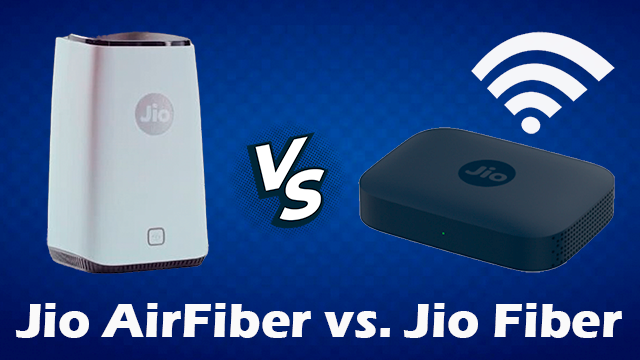In today’s digital age, having a reliable and high-speed internet connection is essential for both work and leisure. Reliance Jio, a leading telecommunications company in India, offers two primary broadband services: Jio Fiber and Jio AirFiber. These services cater to the ever-increasing demand for faster and more accessible internet connectivity. Let’s dive into the key differences, pricing, availability, and other essential aspects of Jio AirFiber and Jio Fiber to help you make an informed decision.
1. Technology :
Jio Fiber: Jio Fiber primarily uses Fiber-to-the-Home (FTTH) technology. This means that the internet is delivered through optical fibers directly to your home, ensuring blazing-fast speeds and minimal latency.
Jio AirFiber: Jio AirFiber employs Fixed Wireless Access (FWA) technology, utilizing radio waves to transmit internet signals from nearby cell towers to a receiver installed at your premises. While not as fast as FTTH, it offers a convenient wireless solution.
2. Pricing :
Jio Fiber: Jio Fiber offers a variety of plans to suit different budgets. Monthly plans start from as low as ₹399 and go up to ₹8,499 for the highest speed plans. The pricing depends on the speed and data cap you choose.
Jio AirFiber: Jio AirFiber also offers competitive pricing, with plans starting around ₹699 per month. The cost may vary based on your location and the selected plan.
3. Availability :
Jio Fiber: Jio Fiber is available in several cities and towns across India. Reliance Jio continues to expand its reach, so availability is increasing over time.
Jio AirFiber: Jio AirFiber is designed to provide internet connectivity in areas where laying fiber optic cables may not be feasible. It is available in select regions, primarily in rural and semi-urban areas.
4. Speed :
Jio Fiber: Jio Fiber is renowned for its high-speed plans, offering up to 1 Gbps (Gigabit per second) internet speeds. This is ideal for heavy internet users, gamers, and households with multiple devices.
Jio AirFiber: Jio AirFiber provides decent speeds, typically ranging from 30 Mbps to 500 Mbps, depending on your location and plan. It’s suitable for standard internet activities but may not be as fast as Jio Fiber.
5. Data Caps :
Jio Fiber: Many Jio Fiber plans come with a high-speed data cap, typically ranging from 100 GB to 5,000 GB, depending on your chosen plan. After exceeding the limit, the speed may be reduced or additional charges may apply.
Jio AirFiber: Jio AirFiber plans usually come with data caps as well. These caps vary from plan to plan and can be a factor in choosing the right package for your needs.
6. Installation :
Jio Fiber: Installing Jio Fiber requires the laying of fiber optic cables to your home, which might take some time. A technician will visit your premises for installation.
Jio AirFiber: Jio AirFiber installation is relatively quicker and more straightforward, as it involves setting up a receiver and router at your location. The installation process is less intrusive compared to digging trenches for fiber cables.
Conclusion :
The choice between Jio Fiber and Jio AirFiber depends on your specific requirements, location, and budget. If you prioritize high-speed internet and are in an area where Jio Fiber is available, it might be the better choice. On the other hand, if you need a more flexible and wireless solution, Jio AirFiber could be a viable option.

